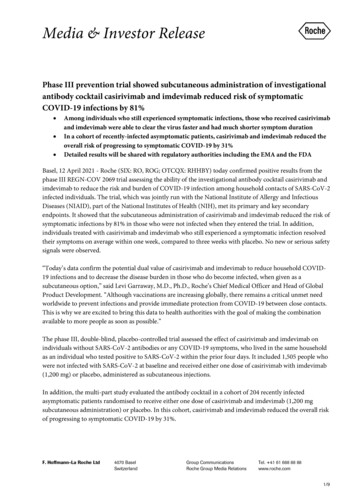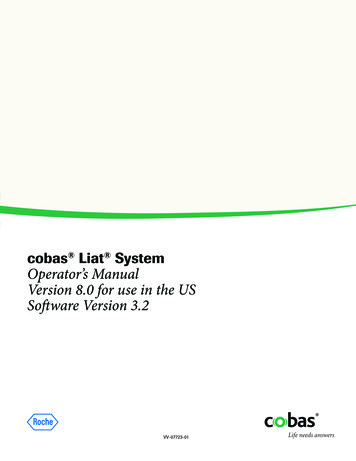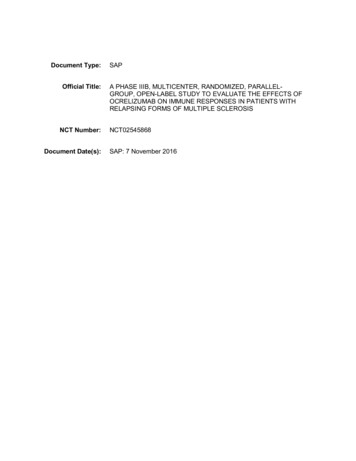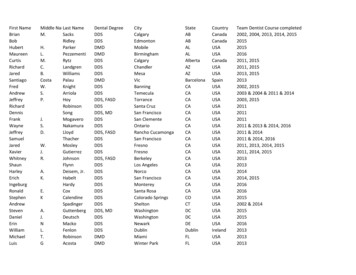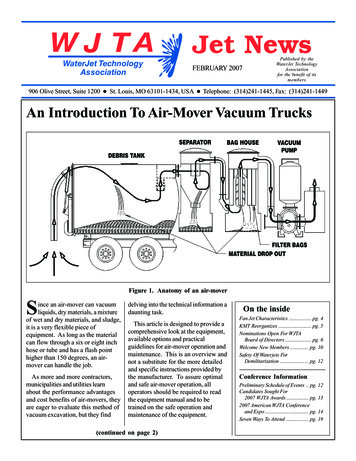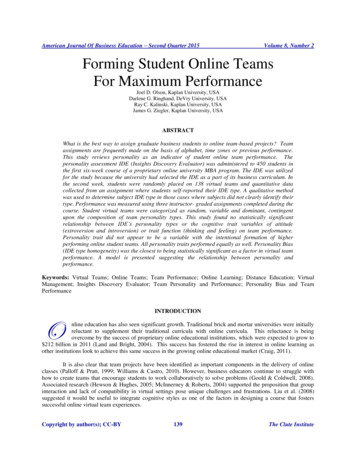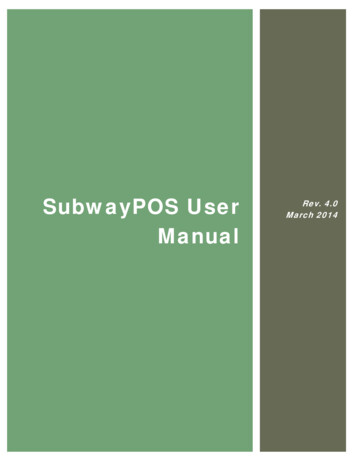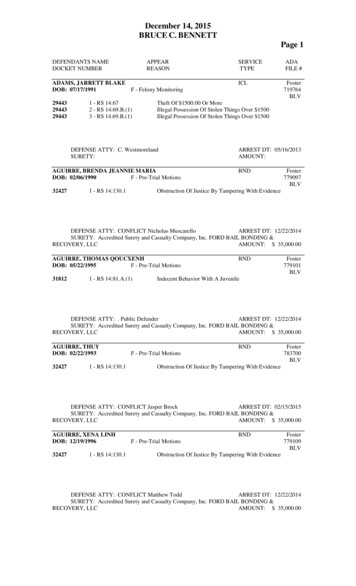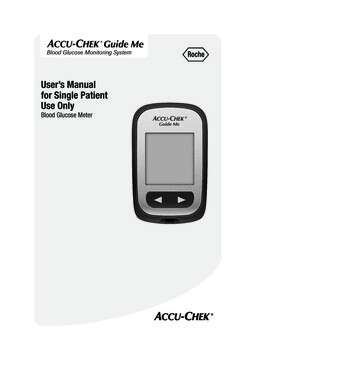
Transcription
1 09241337001 EN.indd 1Blood Glucose Monitoring SystemUser’s Manualfor Single PatientUse OnlyThis file may not print or view at 100%.Die lines and color breaks do not print.“Holding Area” text, box and rules donot print.Roche USA – 81401V1/1 09241337001 – BlackBlood Glucose Meter4/30/2020 11:34:32 AM
ContentsImportant Safety Information. 2Chapter 1: Your New System. 5Chapter 2: The Accu‑Chek Softclix Lancing Device. 10Chapter 3: Blood Glucose Tests. 12Chapter 4: Control Tests. 18Chapter 5: Review Your Data. 22Chapter 6: Wireless Communication, Meter Pairing, and Data Transfer. 24Chapter 7: Meter and Lancing Device Cleaning and Disinfecting. 27Chapter 8: Meter Maintenance and Troubleshooting. 31Chapter 9: Technical Information. 36Chapter 10: License and Warranty. 40Index. 431 09241337001 EN.indd 114/30/2020 11:34:32 AM
Important Safety InformationThe Accu‑Chek Guide Me SystemWARNINGThe Accu‑Chek Guide Me Blood GlucoseMonitoring System is comprised of theAccu‑Chek Guide Me meter and Accu‑ChekGuide test strips. C hoking hazard. Small parts.Keep away from childrenunder the age of 3 years. Keep new and used batteries awayfrom children. Ingestion or insertioninto the body may cause chemicalburns, perforation of soft tissues, anddeath. Severe burns may occur within2 hours of swallowing. If you think abattery might have been swallowedor placed inside any part of the body,seek medical attention immediately.The Accu‑Chek Guide Me Blood GlucoseMonitoring System is intended toquantitatively measure glucose in freshcapillary whole blood from the fingertip,palm, and upper arm as an aid in monitoringthe effectiveness of glucose control.The Accu‑Chek Guide Me Blood GlucoseMonitoring System is intended for in vitrodiagnostic single‑patient use by people withdiabetes. If the battery compartment does notclose securely, stop using the productand keep it away from children.Contact the Accu‑Chek Customer CareService Center at 1-800-858-8072.The Accu‑Chek Guide Me Blood GlucoseMonitoring System is intended to be used bya single person and should not be shared.This system is not for use in diagnosis orscreening of diabetes mellitus, nor forneonatal use.NOTE The term “blood glucose” is used whenreferring to blood sugar.Alternative site testing should be done onlyduring steady-state times (when glucose isnot changing rapidly). Sample data screens are shownthroughout the manual. Your data willdiffer.Accu‑Chek Guide control solutions are foruse with the Accu‑Chek Guide Me BloodGlucose Monitoring System to check that themeters and test strips are working togetherproperly and that the test is performingcorrectly.Limitations Do not use the meter at high hematocritlevels above 65 % or low hematocritlevels below 10 %. Not for use in diagnosis or screening ofdiabetes mellitus. Not for neonatal use. Abnormally high concentrations ofascorbic acid (vitamin C) resulting in bloodconcentrations in excess of 5 mg/dL maycause inaccurate results. If you are notsure please check with your doctor.The system includes:Accu‑Chek Guide Me meter with batteries,Accu‑Chek Guide test strips,* Accu‑ChekGuide control solutions,* Accu‑Chek Softclixlancing device,* Accu‑Chek Softclix lancets.**Some items may not be included in the kit.They are a separate purchase.1 09241337001 EN.indd 224/30/2020 11:34:33 AM
Important Safety Informationback-up meter and test strips. Askyour healthcare professional orpharmacist about other possibleback-up methods. Do not use the meter system to measureblood glucose in people who areexperiencing cardiovascular collapse(severe shock) or decreased peripheralblood flow. Do not use this system during xyloseabsorption test. Not for use on critically ill patients,patients in shock, dehydrated patients, orhyperosmolar patients. This system has not been tested ataltitudes higher than 10,150 feet. If your blood glucose result does notmatch how you feel and you havefollowed the instructions in thisUser’s Manual, follow your healthcareprofessional’s instructions, or contactyour healthcare professional.WARNING During normal testing, any bloodglucose meter or lancing device maycome in contact with blood. All partsof the kit are consideredbiohazardous and can potentiallytransmit infectious diseases frombloodborne pathogens, even after youhave performed cleaning anddisinfecting.1,2Need Help?For questions, contact the Accu‑ChekCustomer Care Service Center toll-free at1-800-858-8072. Hours of operation areMonday through Friday between 8:00 amand 8:00 pm eastern standard time (EST).We offer assistance in many languages. Youcan also visit accu‑chek.com for diabetesmanagement tools and productdemonstrations. The meter and lancing device shouldnever be used by more than oneperson. Do not share the meter andlancing device with anyone, includingfamily members, due to the risk ofinfection from bloodborne pathogens.1,2Do not use on multiple patients!Please register your meter online ataccu‑chek.com/register so you receive thebest customer service possible, in additionto product updates. Cleaning and disinfecting the meterand lancing device destroys most,but not necessarily all, bloodbornepathogens.3About Testing Yourself or Others1 09241337001 EN.indd 3WARNING DO NOT CHANGE YOUR THERAPYBASED ON A TEST RESULT THAT DOESNOT MATCH HOW YOU FEEL OR IF YOUBELIEVE THAT YOUR TEST RESULTCOULD BE INCORRECT. If the meter is being operated by asecond person who is providingtesting assistance to the user, themeter and lancing device should becleaned and disinfected prior to useby the second person. It is strongly recommended to have aback-up testing method available.Failure to test could cause a delay intherapy decisions and lead to aserious medical condition. Examplesof back-up testing methods include a Disinfect the meter and lancing devicebefore allowing anyone else to handlethem. Do not allow anyone else to testwith the meter or lancing device.34/30/2020 11:34:33 AM
Important Safety InformationBefore You Start Testing It is important to keep the meter andlancing device clean and disinfected.For instructions on how to clean anddisinfect the meter and lancingdevice, see the chapter Meter andLancing Device Cleaning andDisinfecting.WARNING Carefully read and follow theinstructions in the User’s Manual andpackage inserts for the test stripsand control solutions. It is veryimportant to follow the instructionsin order to avoid an incorrect testresult that leads to improper therapy. Wash hands and dry thoroughlybefore and after handling the meter,lancing device, or test strips. Inspect the test strip container beforeusing the test strips for the first time.If you see any damage to thecontainer cap or if anything preventsthe cap from closing properly, do notuse the test strips. Contact theAccu‑Chek Customer Care ServiceCenter. Damaged test strips cancause inaccurate results, which couldlead to improper therapy.NOTE Perform a control test when you open anew test strip box or if you think that atest result is incorrect. Performing acontrol test lets you know that themeter and test strips are workingproperly. Refer to the test strip and controlsolution package inserts for additionalhealth-related information. The meter, test strips, and controlsolution are only for use outside thebody (in vitro). Do not eat the teststrips. Do not swallow or inject thecontrol solution or use the controlsolution for any purpose other thantesting the Accu‑Chek Guide Mesystem. Blood glucose and BG areinterchangeable and mean the samething.Special Information for Caregivers Consult your healthcare professional todetermine if it is appropriate for your childto be taught how to use the meter systemor any other medical products. Some people with diabetes do notexperience symptoms of low bloodglucose (hypoglycemia). Others, such aschildren or people who are unconscious orhave certain disabilities, may not be ableto communicate their symptoms tocaregivers. For these reasons, do notchange any therapy without first talking toa healthcare professional.1 09241337001 EN.indd 4NOTESet the time and date on the meter beforeyou begin testing.44/30/2020 11:34:33 AM
1Your New SystemThe Accu‑Chek Guide Me Meter167345Front ViewBack View1. Power/Set ButtonSide View6. Battery DoorTurns meter on or off and sets options.Open to replace batteries.2. Display7. Micro USB PortShows results, messages, and testresults stored in memory.Transfers data from meter to acomputer (PC).3. Left Arrow ButtonPress to enter memory, adjust settings,and scroll through test results.4. Right Arrow ButtonPress to enter memory, adjust settings,and scroll through averages.5. Test Strip Slot1 09241337001 EN.indd 5Insert test strip here.54/30/2020 11:34:40 AM
1Your New System9CB8DA8. Test Strip Container*11. Control Solution Bottle*9. Test Strip* – Metallic End12. BatteriesInsert this end into meter.13. USB Cable*10. Test Strip* – Yellow EdgeConnects meter to a PC.Touch blood drop or control solutionhere.The Accu‑Chek Softclix Lancing Device12341. Cap with Comfort Dial DepthSelection54. Priming ButtonPress to prime.For fingertip testing.5. Lancet2. Ejector* Some items may be sold separately.Slide to release lancet.3. Release Button1 09241337001 EN.indd 6Press to prick.64/30/2020 11:34:44 AM
1Your New SystemUsing the Meter ButtonsWhen instructed to press a meter button,press it briefly and release it.When instructed to press and hold a meterbutton, press and hold it for 3 or moreseconds.Button FunctionsHere are the functions of the power/setbutton and arrow buttons on the meter.These functions are used throughout thismanual.Button1 09241337001 EN.indd 7FunctionActionTurn the meter on or off.Press and release.[power/set Navigate to an option or set abutton] selection.Check the meter display.With the meter off, press and hold tosee the complete meter display. Ifone of the segments is missing orlooks different from this picture, donot use the meter. Contact theAccu‑Chek Customer Care ServiceCenter at 1-800-858-8072.set-upmemory[left arrowand rightarrowbuttons]Adjust settings for time and date andscroll through test results in memory.Press and release or press and holdto scroll faster.74/30/2020 11:34:47 AM
1Your New SystemSymbols1 09241337001 EN.indd 8SymbolDescription7-day average symbol. This indicates that you are viewing the 7-day averageof your blood glucose results.14-day average symbol. This indicates that you are viewing the 14-dayaverage of your blood glucose results.30-day average symbol. This indicates that you are viewing the 30-dayaverage of your blood glucose results.90-day average symbol. This indicates that you are viewing the 90-dayaverage of your blood glucose results.Bluetooth symbolControl bottle symbolDrop symbolHourglass symbolLow battery symbolNo data to displayPairing symbol. A flashing symbol indicates the meter is attempting to pair witha device. A solid symbol indicates the meter pairing was successful.Temperature warning symbolTest strip symbol. A flashing symbol indicates the meter is ready for you toinsert a test strip.Wireless symbol. A flashing symbol indicates the meter is attempting toconnect to the paired device. A solid symbol indicates the meter is connectedto a paired device.84/30/2020 11:35:07 AM
1Your New SystemSetting the Time and Date1 09241337001 EN.indd 9NOTE1Press and releaseto turn the meter on. The meter prompts you to set the timeand date the first time you turn themeter on or if an error occurs.The flashing test stripsymbol appears onthe display. Press and hold at any time until theflashing test strip symbol appears toperform a test. The time and date on the metersynchronize to the time and date onthe paired device each time the metersends data to the paired device.2set-upPress and holduntil set‑up appearson the display. Thehour flashes.ortoPressdecrease or increasethe hour.3set-upPress to set thehour and move to thenext field.4Repeat steps 2 and 3to set minutes, am orpm, month, day, andyear. Press and holduntil the flashingtest strip symbolappears. Insert a test strip to perform atest.94/30/2020 11:35:10 AM
2The Accu‑Chek Softclix Lancing DeviceUsing the Accu‑Chek Softclix Lancing Device The black cap is for fingertip testing only. Remove the cap by pulling it straight off. Do not twist the cap. The penetration depth indicator on the comfort dial shows the currentdepth setting. The higher the number, the deeper the penetration. Thebest depth setting is the lowest number that lets you get enough bloodfor a test. Try different depth settings to find the one that is right foryou. For soft skin, we suggest a depth setting of 2. For thick skin, try ahigher depth setting.Inserting a Lancet3You must first insert a lancet into thelancing device to get it ready for use.Twist off the lancet’sprotective cap.1Remove the lancingdevice cap by pulling itstraight off. Do not twistthe cap.4Place the cap back onthe lancing device.Make sure the notch onthe cap lines up withthe notch on thelancing device.21 09241337001 EN.indd 10Insert a new lancet intothe lancing device untilit clicks.104/30/2020 11:35:13 AM
2The Accu-Chek Softclix Lancing DeviceUsing the Accu‑Chek SoftclixLancing Device1Adjust the lancet depthby turning the comfortdial.2Press the primingbutton in as far as itwill go, like a pen.The release buttonturns yellow when thelancing device is ready.3Obtain a blood drop. See the chapterBlood Glucose Tests.NOTE DO NOT press the release button whilepressing the priming button. ALWAYS use a new, sterile lancet eachtime you test to avoid infection. NEVER reuse a lancet. NEVER share your lancing device withanyone.1 09241337001 EN.indd 11114/30/2020 11:35:14 AM
3Blood Glucose Testsmeter and/or test strip could bedamaged. Discard the test strip andperform a control test with controlsolution and a new, unused test stripto ensure the meter and test stripsare both working properly. Thenrepeat the blood glucose test with anew test strip.WARNING The meter and lancing device shouldnever be used by more than oneperson. Do not share the meter andlancing device with anyone,including family members, due tothe risk of infection from bloodbornepathogens.1,2 Do not use on multiplepatients! DO NOT remove test strips from thetest strip container and put them intoanother container, such as a plasticbag, pocket, purse, wallet, etc. Storingtest strips outside of the test stripcontainer can damage the test stripsand lead to inaccurate results. It isimportant that the test strips remainin their original container until thetime of use. Blood glucose results can be displayedin either mg/dL or mmol/L. The backlabel of the meter shows the unit ofmeasurement. If the meter shows thewrong unit, contact the Accu‑ChekCustomer Care Service Center at1-800-858-8072. The correct unit ofmeasurement in the US is mg/dL. If youdo not know which unit ofmeasurement is correct for you,contact your healthcare professional.Using the wrong unit of measurementmay cause misinterpretation of youractual blood glucose level and maylead to improper therapy. DO NOT expose test strips to heat,moisture, or humidity. Temperaturesoutside the required range, as well asmoisture and humidity, can damagethe test strips and lead to inaccurateresults. DO NOT bend, cut, or alter the teststrips. DO NOT get dirt, food, or othermaterial on the test strip. When performing a blood glucosetest, remove your finger from the teststrip after the test strip is dosed andthe flashing hourglass symbolappears on the meter. Failure to moveyour finger away from the test stripduring measurement could giveinaccurate results.mg/dL or mmol/L is printed hereUsing the Accu‑Chek Guide MeSystemWARNINGTo prevent inaccurate results: If you drop the meter or drop themeter with a test strip inserted, the1 09241337001 EN.indd 12124/30/2020 11:35:17 AM
3Blood Glucose Tests The Accu‑Chek Guide test strips are fortesting fresh capillary whole blood. Use only Accu‑Chek Guide test strips. Use the test strip immediately afterremoving it from the test strip container. Do not apply blood or control solution tothe test strip before inserting it into themeter. If you applied blood or controlsolution before inserting the test strip intothe meter, retest with a new test strip. If aresult appears before applying blood orcontrol solution, do not act on that result. Close the test strip container tightlyimmediately after removing a test strip.Moisture can damage the test strips andproduce incorrect results. Store the unused test strips in theiroriginal container with the cap tightlyclosed. Discard the test strips if they are past theUse By date printed on the test stripcontainer. If the Use By date is missing orcannot be read, do not use the test strips.Contact the Accu‑Chek Customer CareService Center at 1-800-858-8072. Refer to the test strip package insert fortest strip storage and system operatingconditions. Do not reuse test strips. Once controlsolution or blood has been applied to atest strip, discard it. If a retest isnecessary, use a new test strip. Perform a control test every time youopen a new test strip box.NOTE Before you perform your first bloodglucose test, set the meter time anddate. You need the meter, a test strip, and alancing device with a lancet inserted toperform a blood glucose test. A blood glucose test cannot beperformed while the meter isconnected to a PC with a USB cable. The meter turns off 90 seconds after asuccessful test or 15 seconds after thetest strip is removed, provided no otheraction is taken. There are 2 ways to start a bloodglucose test. Insert a test strip into the meter. Turn the meter on by brieflypressingand insert a test strip.1Wash your hands withwarm soapy water anddry thoroughly. Dirty orwet hands could affecttest results.2Adjust the lancet depthto a comfortablepenetration level.Performing a Blood Glucose Testwith Blood from Your FingertipRefer to the Important Safety Informationsection at the beginning of this manual.1 09241337001 EN.indd 13134/30/2020 11:35:18 AM
3Blood Glucose Tests83Check the Use By dateon the test stripcontainer.Gently squeeze yourfinger to assist theblood flow. This helpsyou get a blood drop.Do not use test stripspast the Use By date.94Touch the yellow edgeof the test strip to theblood drop. Do not putblood on top of the teststrip.Remove a test stripfrom the test stripcontainer.Close the cap tightly.105Remove your fingerfrom the test stripwhen the flashingappears. Failure tomove your finger awayfrom the test strip could give inaccurateresults.Insert the metallic endof the test strip into themeter. The meter turnson.611When the flashingdrop symbol appears,obtain a blood drop.The test resultappears on thedisplay.memoryRemove and discardthe used test strip.7Press the lancingdevice firmly againstthe side of yourfingertip.Press the yellowrelease button to prick your finger.1 09241337001 EN.indd 14144/30/2020 11:35:24 AM
3Blood Glucose TestsPerforming a Blood Glucose Testwith Blood from Your Palm orUpper Arm (Alternative SiteTesting, AST)12Discard the usedlancet. Remove thelancing device cap.Point the lancet awayfrom you.WARNING Do not use alternative site testing tocalibrate a continuous glucosemonitoring system.Slide out the ejector to release the lancetinto a puncture-proof container.Always discard according to localregulations. Do not use alternative site testing tomake insulin dosing calculations.131 09241337001 EN.indd 15 Alternative site testing should bedone only during steady-state times(when glucose is not changingrapidly).Wash hands with soapand water and drythoroughly.You have the option of obtaining a bloodsample from other sites on your bodybesides the fingertip. Alternative sitesinclude the palm and upper arm.Blood obtained from the fingertip can beused at any time to test blood glucose.If blood from an alternative site is used,there are certain times when testing is notappropriate. This is because your bloodglucose level changes faster in yourfingertip than in the alternative sites. Thesedifferences may cause you to misinterpretyour actual blood glucose level, leading toimproper therapy and potential adversehealth effects. Read the next section beforeyou try testing from alternative sites.154/30/2020 11:35:24 AM
3Blood Glucose TestsYou may perform a palmor upper arm test immediately before a meal. while fasting.You may NOT perform apalm or upper arm test up to 2 hours following a meal, when blood glucose valuescan rise quickly. after injecting bolus insulin, when blood glucose valuescan decrease rapidly. after exercise. if you are sick. if you think your blood glucose is low (hypoglycemia). if you sometimes do not notice when your blood glucose islow.If you are interested in AST, talk to your healthcare professional first.To obtain an AST cap and detailed AST instructions, contact the Accu‑Chek Customer CareService Center at 1-800-858-8072.Unusual Blood Glucose ResultsIf your blood glucose result does not match how you feel, follow these steps:1. Perform a control test. See the chapter Control Tests.2. Repeat the blood glucose test.If your blood glucose result still does not match how you feel, follow your healthcareprofessional’s instructions or contact your healthcare professional immediately.NOTEAlways follow your healthcare professional’s instructions. For example, if your healthcareprofessional has advised you to immediately treat a low blood glucose result (such as byeating something), then do that first.WARNING Do not change your treatment because of one blood glucose result. NEVER ignore symptoms of low or high blood glucose.1 09241337001 EN.indd 16164/30/2020 11:35:24 AM
3Blood Glucose TestsSymptoms of Low or High Blood GlucoseWARNING The meter is designed to provide a numerical value for blood glucose in the range of20–600 mg/dL. Being aware of the symptoms of low or high blood glucose can help you understandyour test results and decide what to do if they seem unusual. Low blood glucose (hypoglycemia): Symptoms of hypoglycemia may include, but arenot limited to, anxiety, shakiness, sweating, headache, increased hunger, dizziness,pale skin color, sudden change in mood or irritability, fatigue, difficultyconcentrating, clumsiness, palpitations, and/or confusion. High blood glucose (hyperglycemia): Symptoms of hyperglycemia may include, butare not limited to, increased thirst, frequent urination, blurred vision, drowsiness,and/or unexplained weight loss. If you are experiencing any of these symptoms, or other unusual symptoms, testyour blood glucose from the fingertip. If your blood glucose result is displayed as LOor HI, follow your healthcare professional’s instructions or contact your healthcareprofessional immediately. If your blood glucose result does not match how you feel,follow the steps in the Unusual Blood Glucose Results section of this chapter.Comparing Your Meter Result to a Laboratory ResultA common question is how the blood glucose results on the meter compare to the laboratoryresults. Your blood glucose can change quickly, especially after eating, taking medication, orphysical activity. If you test yourself in the morning, then go to your healthcare professional’soffice for a blood glucose test, your test results will probably not match, even if you arefasting. This is typically not a problem with the meter, it just means that time has elapsedand your blood glucose level has changed.Although you always apply fresh capillary whole blood to the test strip, the system has beencalibrated to deliver plasma-like values for easier comparison to laboratory results.If you want to compare your meter result to the laboratory result, you must be fasting. Takethe meter to your healthcare professional’s office and test yourself by fingerstick within 5minutes of having blood drawn from your arm by a healthcare professional. Keep in mindthat the laboratory uses different technology than the meter and that blood glucose metersfor self-testing generally read somewhat lower than the laboratory result.1 09241337001 EN.indd 17174/30/2020 11:35:24 AM
4Control TestsWhen to Perform a Control Test The control solution can stain fabric.Remove stains by washing with soap andwater. Control solution is available for purchase.To order the control solution, talk to yourpharmacist or visit accu‑chek.com toorder online.Performing a control test lets you know themeter and test strips are working properly.You should perform a control test when: you open a new test strip box. you left the test strip container open. you think the test strips are damaged. you want to check the meter and teststrips. the test strips were stored in extremetemperatures, humidity, or both. you dropped the meter. your test result does not match how youfeel. you want to check if you are performingthe test correctly.Performing a Control TestNOTE Most people just test the Level 1control. If you wish, you can also test aLevel 2 control. A set of Level 1 andLevel 2 control solutions is availablefor purchase. The ranges for Level 1 and Level 2controls are printed on the test stripcontainer label.About the Control Solutions Use only Accu‑Chek Guide controlsolutions. Close the control solution bottle tightlyafter use. Write the date you open the controlsolution bottle on the bottle label. Thecontrol solution must be discarded3 months from the date the controlsolution bottle was opened (discard date)or on the Use By date on the bottle label,whichever comes first. Do not use control solution that is pastthe Use By or discard date. Refer to the control solution packageinsert for control solution storageconditions. The meter automatically recognizes thedifference between the control solutionand blood. The control results are not displayed inmemory.1 09241337001 EN.indd 18 The meter turns off 90 seconds after asuccessful test or 15 seconds after thetest strip is removed, provided no otheraction is taken.You need the meter, a test strip, and controlsolution Level 1 or Level 2.1Check the Use By dateon the test stripcontainer. Do not usetest strips past the UseBy date.184/30/2020 11:35:25 AM
4Control Tests26Remove a test stripfrom the test stripcontainer.Touch the drop to theyellow edge of thetest strip. Do not putcontrol solution on topof the test strip.Close the cap tightly.73A flashing appearswhen there is enoughcontrol solution in thetest strip.Insert the metallic endof the test strip into themeter. Place the meteron a flat surface.8The meter turns on.A flashing dropsymbol appears.orThe control result, the bottle symbol, andthe flashing L1 or L2 appear on thedisplay. Press to confirm the controllevel you tested.4Select the controlsolution to test. You willconfirm the level laterin the test.orPressand L2.to alternate between L1951 09241337001 EN.indd 19Remove the bottlecap. Wipe the tip ofthe bottle with atissue. Squeeze thebottle until a tiny dropforms at the tip.orOK appears if the control result is withinrange.Err appears if the control result is out ofrange.194/30/2020 11:35:32 AM
4Control Tests10Wipe the tip of thebottle with a tissue.Cap the bottle tightly.Remove and discardthe used test strip.Understanding Out‑of‑RangeControl ResultsWARNING The control range applies only to acontrol result. It only indicates thatthe test strips and meter areworking properly. Do not use acontrol result to interpret bloodglucose results. If the control result is out of range,do not use the meter until you solvethe problem. Check the followinglist to help solve the problem.1 09241337001 EN.indd 20204/30/2020 11:35:32 AM
4Control TestsTroubleshooting ChecksActionWere the test strips or controlsolutions expired?Discard the test strips or control solution if either ispast the Use By date. If the control solution wasopened more than 3 months ago, discard it. Repeatthe control test with an unexpired test strip and anunexpired control solution.Did you wipe the tip of the controlsolution bottle before use?Wipe the tip of the bottle with a tissue. Repeat thecontrol test with a new test strip and a fresh drop ofcontrol solution.Were the caps on the test stripcontainer and the control solutionbottle always closed tightly?Replace the test strips or control solution if youthink either was uncapped for some time. Repeatthe control test.Was the test strip used immediately Repeat the control test with a new test strip and aafter it was removed from the testfresh drop of control solution.strip container?Were the test strips and controlsolutions stored in a cool, dryplace?Repeat the control test with a properly stored teststrip or control solution.Did you follow the directions?Read the chapter Control Tests and repeat thecontrol test.Did you choose the correct controlsolution level, either 1 or 2, whenyou performed the control test?If you chose the wrong control solution level, youcan still compare the control result to the rangeprinted on the test strip container.Are you still unsure of
Set the time and date on the meter before you begin testing. 81401_09241337001_EN.indd 4 4/30/2020 11:34:33 AM. 5 1 Your New System The Accu‑Chek Guide Me Meter 1 4 5 3 7 6 Front View Back View Side View 1. Power/Set Button Turns meter on or off and s
